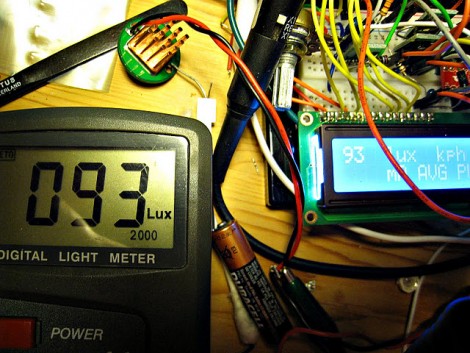
[Minisystem] has a thing for dynamo powered bike lights. He wanted to measure how well his latest is working, but just logging the current flow through the LEDs wasn’t enough for him. He picked up a cheap Lux meter and hacked into the circuit to log measurements while he rides.
He started by cracking open the case to see what the meter held inside. There’s a Texas Instruments Op-Amp that connects to the light sensor. The datasheet for the part didn’t help much, but [Minisystem] did find that the current output on one of the pins changes with light intensity. Further testing led him to discover that the signal is a multiple of 10 for what is shown on the Lux meter’s readout. All he needs to do is take regular measurement of this current and save that data.
To do this, he grabbed his trusty Arduino and made a connection between one of its analog inputs and the op-amp pin. It should be easy enough to dump measurements into the Arduino’s own EEPROM, or use an external storage chip or SD card.
[Thanks Jason]














And I just paid for two logging Lux meters at $180 each. This can save me some coin, thanks!
Nice project, love his sight too.
I’ll make use of this.
Amazon has some cheap ones:
http://www.amazon.com/Light-Meter-LX1010B-Luxmeter-display/dp/B000JWUT6O
$15 for a lux meter that works? Amazing modern technology.
I’ve been thinking of making a lux meter by my self for some time now and bought some bare light sensors a year ago.
TSL235 is a light to frequency converter which has a truly amazing range and resolution and are very easy to interface with a microcontroller. In the same family there are also versions with rgb filters built in for color measurement.
Really? You thought that precise current measurement was not a good way of measuring output, so you decided to measure the light output instead? Do you know for a fact that light output is perfectly proportional to power output, and that intensity changes linearly with power?
Wow.
@NATO. The current:luminous flux curve is almost, but not quite linear. See here: http://www.cree.com/products/pdf/XLampXM-L.pdf (page 5)
Current is a good enough estimation of light output except in the case where LED temperature is changing. If the LED is getting constant current, the light output goes down as the LED heats up. In this case, power into the LED remains constant, but light output changes. I’m testing various heat sink configurations, so measuring the light output on different heat sinks is necessary for optimization.
Nato,
You do realize there’s a driver between the LED and the battery? what, you thought the LED was driven without any additional circuitry?
Wow.